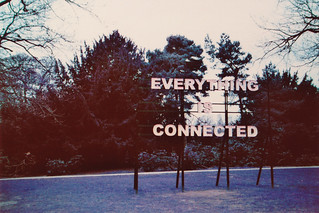I’m in my 5th year of teaching, after changing careers, studying and moving countries. Over the past 3 years I have become more engrossed and aware of the emergence of connected learning environments. From joining Twitter, reading blogs, writing blogs, listening to podcasts, and connecting with educators across Australia and the world. It constantly amazes me the wealth of knowledge and sharing that connected educators are doing online, and it encourages and inspires me every day. ‘Connected Learning’ and ‘Digital Literacy’ is quickly evolving into foundations of my own teaching strategies. In a rapidly evolving world of information technology, it is becoming paramount as a teacher that I’m able to develop these areas in my students and allow them to develop their skills.
creative commons licensed (BY) flickr photo by auspices: http://flickr.com/photos/auspices/14892685406
Technology has allowed new connections, interactions and participatory cultures to emerge. To be able to to use theses to the best effect, we foremost need to have a clear understanding and grasp of ‘Digital Literacy’ and how it relates to education. Bawden (2008) identifies a number of key facets of digital literacy; they include areas such as knowledge assembly, retrieval skills, critical thinking, using people networks and publishing information. This reflects strongly with my own teaching context whereas a History teacher these skills are key – Finding information, collecting it and being critical of the information in conducting a historical inquiry, forms the bedrock of research in History. The other aspects of using networks and publishing the created information is the missing element, and this is where I see further progression needs to take place within my own teaching context for my students.
Connected Learning would not be able to exist without Digital Literacy. Connected learning should be part of our daily lives as educators, we have the ability to connect with other educators online through Twitter, Blogs, and many other ways. However many of my students are still not utilising their connections to facilitate learning, and this is the area to focus on. This ties in well with what Helen Haste argues that in the future people will need to be able to adapt to change, to use new and old tools effectively, and to be confident that they can act in effective ways. These students are the future citizens, the future workers, the future inventors, the future leaders and they will need a set of skills that is different to what I grew up with. Louise Starkey (2011) also supports these ideas about learning, “… appears to be slowly evolving from a focus on what has already been discovered and prescribed as ‘knowledge’ towards a focus on critical thinking skills, knowledge creation and learning through connections.”. Through this the learning theory of ‘Connectivism’ is explained by George Siemens(2015) as being the “amplification of learning, knowledge and understanding through the extension of a personal network”. The Digital Media & Learning Research Hub is a fantastic resource place that explores, and showcase connected learning and what the key principles are. Quoted from their website: “….connected learning calls on today’s interactive and networked media in an effort to make these forms of learning more effective, better integrated, and broadly accessible.” Guiding principles include a ‘Shared purpose’, ‘Production-centered’ and ‘Openly networked’.
The connected learning environment, and how to interact with it professionally, socially and innovatively. My future goals will include improving my own understanding and knowledge of these areas, and also teaching my students how to become more digitally literate, more connected with learning and how to become more socially conscious citizens and leverage digital tools for their learning and the benefit of others.
References
Connectedlearning.tv,. (2015). Connected Learning Principles | Connected Learning. Retrieved 29 March 2015, from http://connectedlearning.tv/connected-learning-principles
Siemens, G. (2015). elearnspace. Connectivism: A Learning Theory for the Digital Age.Elearnspace.org. Retrieved 26 March 2015, from http://www.elearnspace.org/Articles/connectivism.htm
Starkey, L. (2011). Evaluating learning in the 21st century: a digital age learning matrix. Technology, Pedagogy And Education, 20(1), 19-39. doi:10.1080/1475939x.2011.554021
YouTube,. (2015). Technology and Youth: Five Competencies (part 3 of 4). Retrieved 19 March 2015, from http://youtu.be/pqt3ZmtBTOE

No comments:
Post a Comment